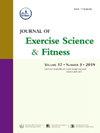在炎热的环境中,通过短暂的鞋底冷冻刺激,增强间歇性运动表现
IF 2.4
2区 医学
Q2 SPORT SCIENCES
引用次数: 0
摘要
目的:本研究旨在评估在高温环境下,短暂低温刺激足底对运动表现、体温调节和心血管功能的影响。方法体力活动健康成人8例(男6例,女2例;平均年龄:24.89±3.10岁)参加本随机交叉自我对照研究。为了确定运动强度,进行最大摄氧量(VO2max)测试作为初步步骤。在至少72小时的间隔后,参与者进行由两个阶段组成的间歇性循环。第一阶段包括以70% VO2max进行15分钟的稳态运动(SSE),然后进行15分钟的最大循环努力(MCE)(≥70% VO2max)。然后参与者以坐姿休息10分钟,在此期间,他们被随机分配到两种条件中的一种:CON(静止休息)或sole - cryo(使用- 50°C冰袋进行2分钟的鞋底冷冻刺激)。休息后,他们进入第二阶段,在超过70% VO2max的强度下完成疲劳时间(TTE)测试。所有运动均在高温环境(35°C, 60%相对湿度)下进行。实验期间,连续监测大鼠食管温度(Tes)、皮肤温度(Tsk)、大腿肌温度(TMT)、皮肤前臂血流量(skin FBF)、心率(HR)、搏量(SV)、心输出量(CO)。每2分钟记录一次运动知觉评分(RPE)和热感觉评分(TS)。结果鞋底冷冻组的衰竭时间明显长于对照组(CON: 3.23±1.07 min vs.鞋底冷冻组:3.92±1.10 min, p <;0.01)。相比之下,Tes在不同条件下无显著差异(p >;0.05)。在10 min的静息期,Tsk (CON: 37.25±0.36°C vs. Sole-Cryo: 36.60±0.42°C, p <;0.05)和皮肤FBF (CON: 12.57±2.71 ml/min/100 ml vs. Sole-Cryo: 10.89±2.25 ml/min/100 ml, p <;0.05),单冷条件下显著降低。然而,TMT、HR、SV和CO在不同条件下保持不变(p >;0.05)。此外,在PT的第52分钟,两种RPE (CON: 19.37±0.74 vs. Sole-Cryo: 16.88±1.26,p <;0.05)和TS(反对:3.75±0.46 vs Sole-Cryo: 2.75±0.46,p & lt;0.05),单冷条件下显著降低。结论在高温环境下休息时对足底进行短暂低温刺激对核心体温和心血管系统无显著影响。然而,它降低了Tsk和皮肤FBF,改善了感知反应,如RPE和热感觉。这些改进可能有助于延长疲劳时间。本文章由计算机程序翻译,如有差异,请以英文原文为准。
Enhancing intermittent exercise performance through brief sole cryostimulation during breaks in a hot environment
Objectives
This study aimed to evaluate the efficacy of brief cryostimulation of the soles of the feet on exercise performance, thermoregulation, and cardiovascular function during an inter-exercise rest period in a hot environment.
Methods
Eight physically active and healthy adults (6 males, 2 females; mean age: 24.89 ± 3.10 years) participated in this randomized crossover self-controlled study. To determine exercise intensity, the maximal oxygen uptake (VO2max) test was conducted as a preliminary step. After a minimum 72-h interval, participants performed intermittent cycling consisting of two phases. The first phase included 15 min of steady-state exercise (SSE) at 70 % VO2max, followed by 15 min of maximal cycling effort (MCE) (≥70 % VO2max). Participants then rested in a seated position for 10 min, during which they were randomly assigned to one of two conditions: CON (stationary rest) or Sole-Cryo (2-min sole cryostimulation using a −50 °C ice pack). After the rest period, they proceeded to the second phase, completing a time-to-exhaustion (TTE) test at an intensity exceeding 70 % VO2max. All exercise sessions were conducted in a hot environment (35 °C, 60 % relative humidity). During the experiment, esophageal temperature (Tes), skin temperature (Tsk), thigh muscle temperature (TMT), skin forearm blood flow (Skin FBF), heart rate (HR), stroke volume (SV), and cardiac output (CO) were continuously monitored. The ratings of perceived exertion (RPE) and thermal sensation (TS) were recorded every 2-min.
Results
Time to exhaustion was significantly longer in the Sole-Cryo condition compared to the CON condition (CON: 3.23 ± 1.07 min vs. Sole-Cryo:3.92 ± 1.10 min, p < 0.01). In contrast, Tes showed no significant difference between conditions (p > 0.05). During the 10-min resting period, both Tsk (CON: 37.25 ± 0.36 °C vs. Sole-Cryo: 36.60 ± 0.42 °C, p < 0.05) and skin FBF (CON: 12.57 ± 2.71 ml/min/100 ml vs. Sole-Cryo: 10.89 ± 2.25 ml/min/100 ml, p < 0.05) were significantly lower in the Sole-Cryo condition. However, TMT, HR, SV, and CO remained unchanged between conditions (p > 0.05). Additionally, at the 52 nd min of PT, both RPE (CON: 19.37 ± 0.74 vs. Sole-Cryo: 16.88 ± 1.26, p < 0.05) and TS (CON: 3.75 ± 0.46 vs. Sole-Cryo: 2.75 ± 0.46, p < 0.05) were significantly lower in the Sole-Cryo condition.
Conclusions
Brief cryostimulation interventions applied to the soles during rest periods in a hot environment did not significantly affect core body temperature or the cardiovascular system. However, it lowered Tsk and skin FBF and improved perceptual responses such as RPE and thermal sensation. These improvements may have contributed to the enhancement of time to exhaustion.
求助全文
通过发布文献求助,成功后即可免费获取论文全文。
去求助
来源期刊
CiteScore
5.10
自引率
3.60%
发文量
54
审稿时长
31 days
期刊介绍:
The Journal of Exercise Science and Fitness is the official peer-reviewed journal of The Society of Chinese Scholars on Exercise Physiology and Fitness (SCSEPF), the Physical Fitness Association of Hong Kong, China (HKPFA), and the Hong Kong Association of Sports Medicine and Sports Science (HKASMSS). It is published twice a year, in June and December, by Elsevier.
The Journal accepts original investigations, comprehensive reviews, case studies and short communications on current topics in exercise science, physical fitness and physical education.

 求助内容:
求助内容: 应助结果提醒方式:
应助结果提醒方式:


